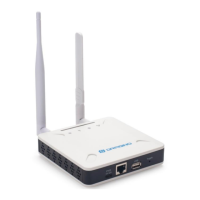
Do you have a question about the Dragino LPS8N and is the answer not in the manual?
Overview of the LPS8N as an open source LoRaWAN Indoor Gateway, bridging LoRa to IP networks.
Details on hardware components, interfaces, WiFi specs, and LoRa specifications.
Highlights the open-source nature, management options, LoRaWAN capabilities, and optional cellular connectivity.
Diagram showing the LPS8N system components and their interconnections.
Methods to find the gateway's IP address via WiFi Access Point or Ethernet connection.
Instructions on how to access and log in to the LPS8N's web configuration interface.
Describes the flexible network setup options supported by the LPS8N.
Default configuration to use the WAN port for internet access via an upstream router.
Configuration steps for the LPS8N to act as a WiFi client connecting to an upstream router.
Instructions for installing a SIM card and using the built-in 3G/4G modem for internet.
How to check the internet connection status through the Home page interface.
Step-by-step guide to register a gateway ID and create a gateway on the TTN v3 server.
Configuring the LPS8N's LoRaWAN settings to connect to the TTN v3 network server.
Setting the correct frequency plan in LPS8N to match the end node for data reception.
Guide on defining and registering LoRaWAN end devices using OTAA keys in TTN v3.
Displays the system running status, including network and IoT service connectivity.
Page for configuring LoRa radio settings, including frequency bands and customization.
Enabling ABP decryption for communication with LoRaWAN ABP End Nodes without a server.
Setup for connecting to general LoRaWAN servers like TTN or AWS IoT.
Setting up LPS8N to transfer data to an MQTT broker, especially for ABP mode.
System information, login settings, timezone, and port forwarding configuration.
Settings for LAN, WAN, and WiFi WAN network configurations.
Settings for WiFi access point and client modes, including SSID and passphrase.
Settings for using the cellular modem as a primary or backup internet connection.
View the current network and WiFi connection status details.
Features for batch configuration and remote management using Auto Provision.
Steps to upload and install new firmware using the web interface.
Options to reboot the device or reset it to factory default settings.
Interface for managing installed software packages and checking for updates.
Steps to connect to the LPS8N's Linux console via SSH for debugging and management.
Methods for editing and transferring files using SCP and SFTP protocols, e.g., with WinSCP.
Information on the LPS8N's flash memory, RAM usage, and storage limitations.
Using the OPKG package manager to install and maintain software on the LPS8N.
Steps to upload and install new firmware using the web interface.
Alternative method to upgrade firmware using the Linux command line.
Guidance on configuring custom frequency bands for the LoRaWAN gateway.
Information on obtaining source code for custom firmware development and branding.
Explanation of compatibility and performance implications when using an 868MHz version with 915MHz bands.
Troubleshooting kernel errors caused by package dependency mismatches using -force-depends.
Instructions on how to recover the gateway if the firmware becomes unstable or crashes.
Steps to regain access using the fall-back IP address when WiFi IP is lost.
Addressing issues where the LPS8N fails to assign a DHCP IP address when connecting to its SSID.
Details on part numbers, frequency bands, and cellular options for ordering.
Information on what is included in the package and the device's physical dimensions and weight.
Information on how to get support, including contact details and wiki resources.
